Looking at the crypto market from a cyclical perspective: What causes the market to rise and fall?

Reprinted from panewslab
01/14/2025·27days agoAuthor: Tulip King; Compiler: Block unicorn
Foreword:
- The abhorrent behavior of @BanklessVC is a clear indication that we have entered a predatory, PvP (player versus player) phase of the market. Protect yourself and your profits.
- I suspect this cycle has peaked and is currently experiencing a natural pullback as the crypto market attempts to release pain - but that pain may linger for some time.
- Coins like virtuals, ai16z, and heyanon may hit new all-time highs in the recovery, but they are subject to narrative risk—continue to reevaluate your worldview.
What's driving the market higher?
It's obvious that the reason why the market rises is because of new money flowing into the market. From now on, I will discuss the concept of new money flowing into the market in relation to the "wealth effect". We should all want the crypto industry to create real value (wealth) in the world and share in the fruits of monetary expansion. This can be achieved in several ways:
1. Create wealth through innovation (airdrop)
Airdrops have become a powerful mechanism for value redistribution in crypto markets, creating significant wealth effects that benefit a wide range of participants. The September 2020 Uniswap airdrop set the standard, distributing 400 UNI tokens (worth approximately $1,400 at the time of release) to over 250,000 addresses, with an eventual total value of over $900 million.
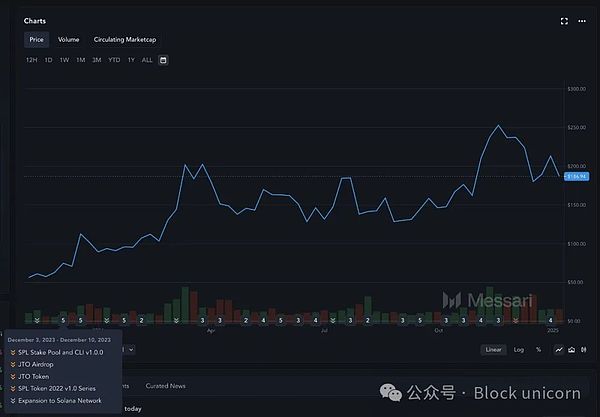 Jito airdrop was an important catalyst in the early stages of the Solana altcoin bull market
The Jito airdrop in December 2023 distributed 90 million JTO tokens with a total value of $165 million, and some users reaped rewards of up to $10,000 just by transferring $40 worth of JitoSOL. The Jito airdrop helped drive growth in Solana’s total value locked (TVL) and fueled increased on-chain activity. This wealth effect stimulates the adoption and development of the broader Solana ecosystem, similar to the catalytic effect of Uniswap's UNI token on DeFi growth.
Jupiter’s method of token distribution further demonstrates the democratizing potential of airdrops. They plan to distribute 700 million JUP tokens to over 2.3 million eligible wallets, making it one of the most widely distributed airdrops in crypto history. Jupiter’s airdrop strategy aims to promote the growth of its ecosystem by incentivizing long-term participation and governance participation. These airdrops have shown remarkable efficiency in expanding market participation.
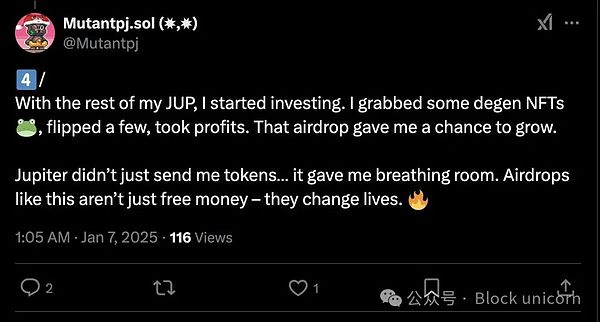 that\'s what i want to say
Wealth effects are not limited to direct financial gains. These airdrops have turned users into stakeholders, allowing them to participate in governance and protocol development. This mechanism creates a virtuous cycle: Beneficial participants invest wealth back into the ecosystem, further driving market expansion and innovation.
These strategic distributions have proven to be powerful market catalysts, triggering broader bull cycles in their respective sectors. Uniswap’s airdrop ignited the DeFi summer of 2020, and its distribution sparked a wave of innovation in the decentralized finance sector. Likewise, Jito’s airdrop in December 2023 became a turning point for the Solana ecosystem, driving TVL growth and catalyzing unprecedented on-chain activity. This surge in liquidity and market confidence set the stage for the altcoin explosion that followed and resulted in significant growth. These airdrops actually act as an economic stimulus for the entire ecosystem, creating self-reinforcing cycles of investment and innovation that define their respective market eras.
2. Increase in wealth (marginal buyers)
When a market experiences a positive catalyst like a strategic airdrop, it attracts previously on-the-side players who bring new capital and enthusiasm. The influx of these marginal buyers creates a virtuous cycle of market expansion and innovation.
 Airdrops triggered positive FOMO, driving new and existing users to participate more deeply in the market
After witnessing successful airdrops and subsequent market momentum, investors on the sidelines began deploying capital and transitioned from bystanders to active market participants. This shift from cash to cryptoassets represents genuine new money entering the ecosystem, not just a transfer between existing players.
Large financial institutions are increasingly driving this shift, including companies such as BlackRock, Fidelity and Franklin Templeton, which are creating products that connect traditional finance with digital assets. Their participation helps legitimize the market and provide an easier entry point for wait-and-see funds to enter the market. This expansion creates a positive-sum environment with new players contributing to overall market growth.
Unlike a zero-sum trading environment, markets fueled by new players create real wealth effects by expanding liquidity, increasing development activity, and expanding adoption. This positive feedback loop attracts more investment capital, further driving the growth of the ecosystem.
3. Create wealth through leverage (multiply expansion)
At the end of a bull market, leverage becomes the primary driver of price increases, marking the transition from value creation to value multiplication. As the market enters the price discovery phase, traders increasingly use leverage to enlarge their positions, creating a self-reinforcing cycle of upward momentum.
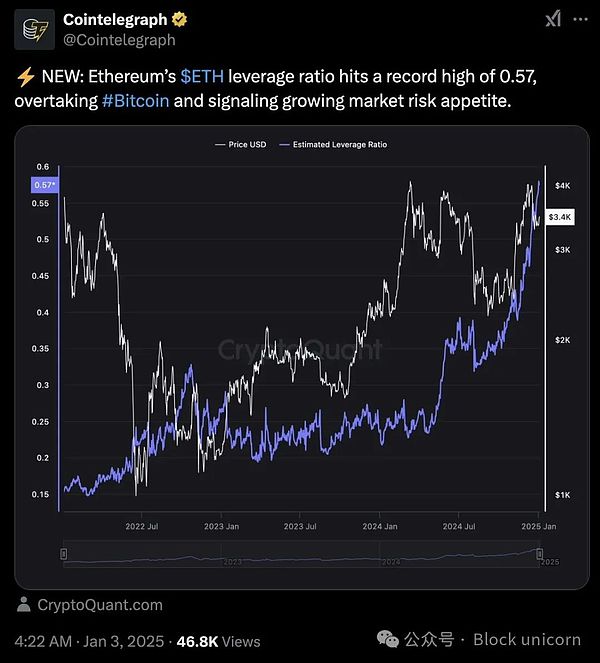 When Bitcoin enters a phase of price discovery above all-time highs, leverage
increases dramatically as traders seek to maximize their risk exposure. This
has a knock-on effect, where borrowed stablecoins drive further purchases,
pushing prices higher and encouraging more leveraged positions. This
multiplier effect accelerates price movements.
When Bitcoin enters a phase of price discovery above all-time highs, leverage
increases dramatically as traders seek to maximize their risk exposure. This
has a knock-on effect, where borrowed stablecoins drive further purchases,
pushing prices higher and encouraging more leveraged positions. This
multiplier effect accelerates price movements.
Increasing leverage also creates systemic vulnerabilities in the market. As more traders take leveraged positions, the likelihood of cascading liquidations increases, especially as borrowed stablecoins become more expensive and difficult to obtain.
The rise in stablecoin borrowing costs is a key indicator that the market is entering its final stages. This represents a critical shift from organic growth to leverage-driven expansion, where no new value is created - just existing value is amplified through debt.
The heavy reliance on leverage at this stage creates an unstable situation, where sudden price swings can trigger large-scale liquidations, leading to rapid price corrections. This fragility signals that the bull market is coming to an end, as the system becomes increasingly reliant on borrowed funds rather than underlying value creation.
What caused the market to fall?
It is also obvious that the market fell because money was flowing out of the market. This is essentially the reverse wealth effect, where speculators take advantage of the animal spirits of the market, with smart money taking chips off the table to lock in profits, and the dumb ones being liquidated.
1. Wealth is extracted from the market
The crypto ecosystem regularly goes through cycles of value extraction, in which savvy operators devise schemes to extract capital from enthusiastic market participants. Rather than productive innovations that distribute value, these schemes systematically remove liquidity from the market through a variety of predatory mechanisms.
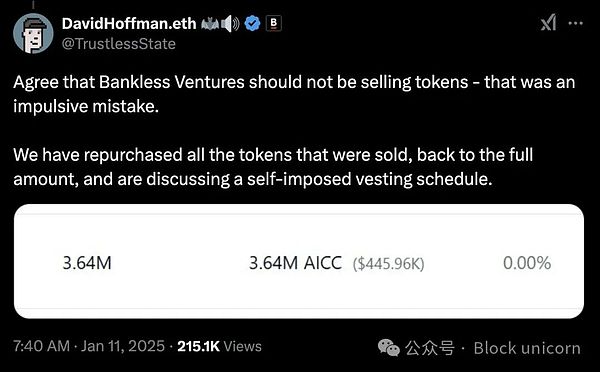 The most disgusting part of the Bankless story is that they drained thousands of SOL from the ecosystem for only 2 SOL
The recent Aiccelerate DAO launch illustrates this evolution - despite being backed by high-profile advisors like Bankless founders and industry veterans, the project began selling off after insiders received the tokens without a lock-up period, The project was immediately criticized. Even big names can become vehicles for rapid value extraction.
Celebrity tokens also reflect this predatory behavior. These projects kill the altcoin cycle by effectively transferring wealth from retail buyers to insiders through malicious smart contracts and coordinated dumping. These withdrawal incidents undermine market confidence and disincentivize legitimate participants. Rather than building a sustainable ecosystem, they create cycles of distrust that undermine the maturity of the broader cryptocurrency ecosystem.
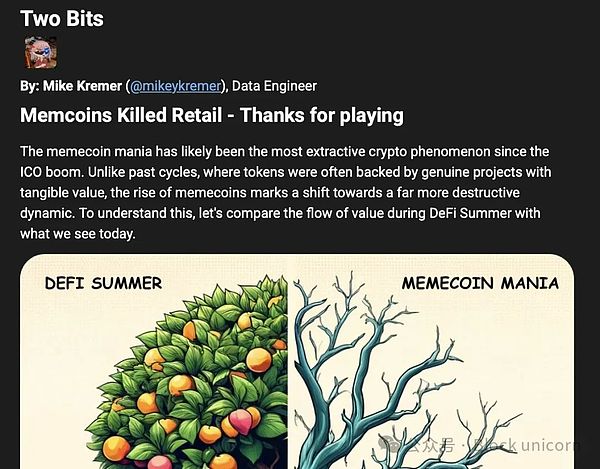 I\'ve discussed this before in the Messari newsletter
Rather than reinvesting profits into ecosystem development, these schemes systematically drain liquidity from the market. Withdrawn funds often exit the crypto ecosystem entirely, reducing the total capital available for legitimate projects and innovations.
The evolution from obvious scams to sophisticated operations backed by high-profile individuals represents a worrying trend. When established institutions engage in rapid value extraction, it becomes increasingly difficult for market participants to differentiate between legitimate projects and sophisticated fraud.
2. Only sellers
 Are you surprised that BAYC reached the top after only 3 months?
When the market starts to fall, a key asymmetry emerges - the gap between sophisticated players who are aware of the changes in the market and retail investors who still believe in the bullish thesis. At this stage, the market is not characterized by the entry of new capital, but by the planned extraction of liquidity by experienced traders.
Professional traders and investment firms began reducing risk exposure while maintaining public optimism. Venture capital firms quietly liquidate positions through OTC markets and strategic exits, protecting capital while avoiding market impact. This approach creates an illusion of stability even as large amounts of capital have exited the system.
Smart investors began to withdraw liquidity from DeFi protocols and trading venues. This subtle but steady flow of liquidity creates increasingly fragile market conditions, although the effects are not immediately visible to the casual observer.
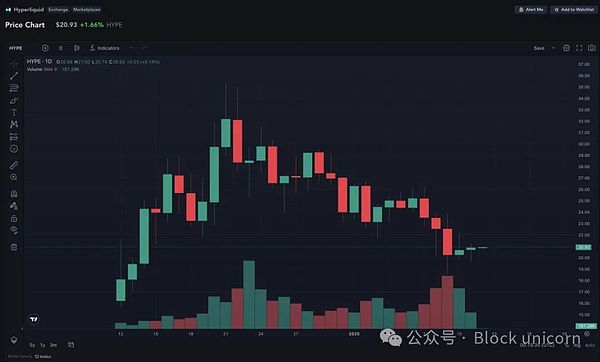 Looks like some smart investors are taking chips off the table
Denial: Although experienced players can make profits, retail investors often still believe that declines are temporary buying opportunities. This cognitive dissonance is reinforced by:
- Social media’s information cocoon maintains bullish narrative
- Attachment to Bull Market Unrealized Gains
- Misinterpretation of the "Diamond Hand" mentality
Most retail investors miss the best exit point, hold on to the initial decline, and try to justify their decisions. By the time a downward trend becomes apparent, a significant amount of value has been lost, panic has increased, and selling pressure has intensified.
The steady withdrawal of professional capital has created deteriorating market conditions, with each subsequent sell order having an increasingly pronounced impact on price. Deteriorations in market depth often go unnoticed until large price movements expose underlying vulnerabilities.
Unlike the positive-sum environment driven by new entrants in a bull market, this phase represents pure value destruction as capital systematically exits the crypto ecosystem and remaining participants have to absorb ever-increasing losses.
3. Leverage explosion (liquidation chain reaction)
The final stages of market capitulation revealed the devastating effects of excessive leverage, as Warren Buffett famously said: “Only when the tide goes out do you discover who was swimming naked.” The most dramatic crash in the crypto market is happening right now It is a clear manifestation of this principle.
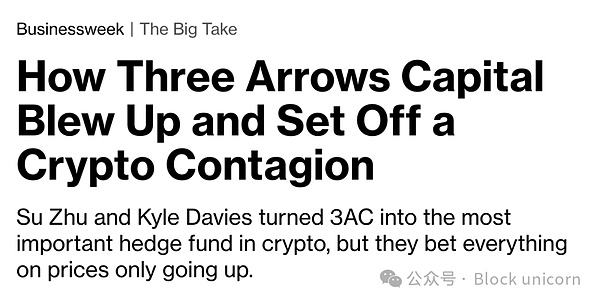
The unraveling began in June 2022 with the collapse of 3AC's $10 billion hedge fund. Their leveraged positions, including $200 million in LUNA and substantial exposure to the Grayscale Bitcoin Trust, triggered a series of forced liquidations. The fund's failure revealed a tangled web of interconnected loans, with more than 20 institutions affected by its default.
FTX’s collapse further illustrates the dangers of hidden leverage. Alameda Research borrowed $10 billion of FTX client funds, creating an unsustainable leverage structure that ultimately led to the collapse of both institutions. The disclosure revealed that 40% of Alameda’s $14.6 billion in assets held illiquid FTT tokens, exposing the vulnerability of their leveraged positions.
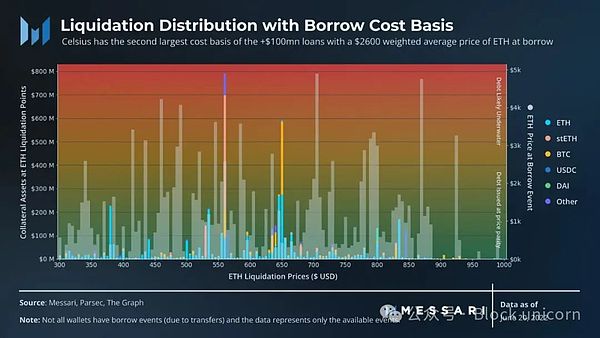 Old research by @Saypien_
These crashes triggered widespread market contagion effects. The collapse of 3AC led to the bankruptcy of several cryptocurrency lenders, including BlockFi, Voyager and Celsius. Likewise, FTX’s collapse had a domino effect across the industry, with many platforms freezing withdrawals and eventually filing for bankruptcy.
Continuous liquidations reveal the true face of market depth. When leveraged positions are forcibly liquidated, asset prices plummet, triggering further liquidations, creating a vicious cycle. This exposes how much of the market's apparent stability is underpinned by leverage rather than true liquidity.
The receding tide revealed that many institutions thought to be mature were actually swimming naked, with inadequate risk management and excessive leverage. The interconnected nature of these positions means that a failure could trigger a system-wide crisis, exposing the vulnerability of the entire crypto ecosystem.
Looking Ahead - Narrative Risk
The title of this article is a bit provocative. My gut tells me this is just a healthy, albeit painful, market shake-up. We will bounce back. Price targets for Bitcoin in particular remain quite high - but I've taken the chips off the table and locked in Bitcoin gains that I'd be willing to carry into the next cycle, if this is indeed the end. Remember, no one goes bankrupt because of profits.
I have written many times about the importance of following the market narrative and not sticking to old coins. The longer this market remains down, the more the narrative will change. If the market fully recovers tomorrow morning, I expect virtuals, ai16z, and virtuals-based tokens to continue to win. But if the market recovery takes longer, then you should keep an eye on emerging coins to see if they can attract new inflows.
You should understand that I am telling you not to have a currency holding bias. Unless you really have a firm belief, do not hold your currency until the downturn. Even if they make new all-time highs, I bet you're missing out on a lot of potential gains by not converting to new coins in a timely manner.
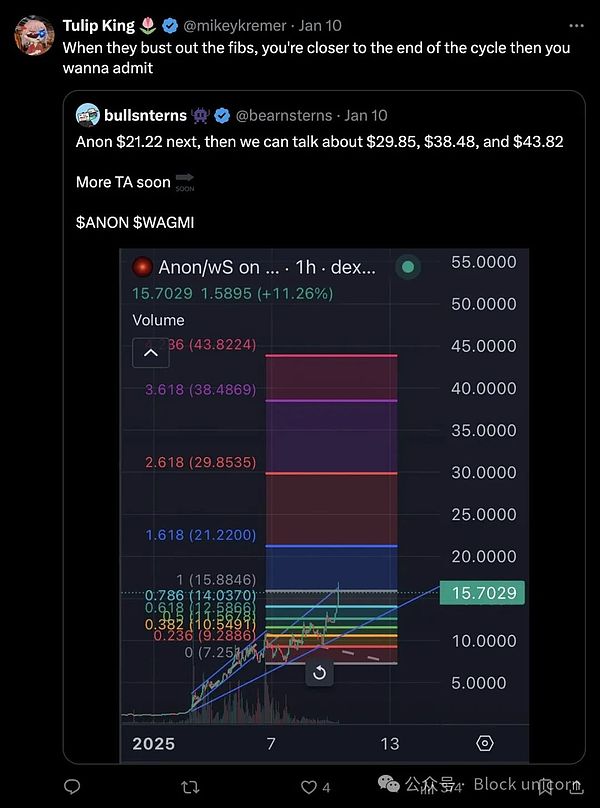 The only reason people post Fibonacci charts is to convince themselves (and
others) that they can sell at a higher price.
The only reason people post Fibonacci charts is to convince themselves (and
others) that they can sell at a higher price.


 chaincatcher
chaincatcher